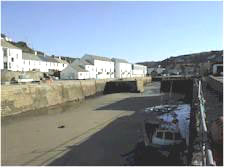



Portreath is a small village on the North coast of Cornwall, between the towns of Camborne and Redruth.
Portreath was transformed from a small fishing village into a busy port by the Bassets, one of Cornwall's richest families in the 18th century. The Bassets lived at the nearby Trehildy estate and owned many of the tin and copper mines in the Redruth area. Copper was exported to Wales for smelting, and Welsh coal and timber brought back for use in the Cornish mines.
The first Portreath harbour was built in 1713 by local mine owners trying to export their ore, but it was soon destroyed by the sea around 1749. Extensive foundations from this port were found in 1984 when shifting sands exposed them.
The present harbour has a long dog-leg wall, and presents shipping with a difficult entrance. There is a building - The Pepper Pot - from which ships were guided through the harbour entrance. Portreath became a thriving port exporting copper in the 19th century. The tram road used horse-drawn wagons to pull the copper ore to the port, from where it was shipped to Swansea in South Wales for smelting. As with other Cornish ports, the ships made the return journey full of Welsh coal.
In 1809 one of the earliest railways in Britain, and the first in Cornwall, was built from Portreath to the St Day mine about 5 miles inland. The final steep section that lowered the wagons down to the harbour can still be seen. Some of the old tram roads have been converted into cycling and walking trails and you can cycle from here to Devoran on the south coast.
There is a small sandy beach, which has a tidal swimming pool under the shelter of the harbour wall on its north end. Because of the old mining activity, the beach sand still contains particles of tin, and it is said, Cornish gold. The south side of the cove dominated by Battery Hill, where cannons were mounted in the 18th century to guard the harbour from foreign attack. A salute of cannon was fired from the Portreath Battery when Lord de Dunstanville laid the keel of the first tram on 25th October 1809.
Smugglers Cottage is an early house in the area, in 1617 "a capson house for the drawing up and saving of boats" was built. In the 1950's, alterations to the cottage exposed a secret room complete with an old sea chest and a rusting sword, and apparently a table with a skeleton seated at it, with the tattered remains of a black cloak around his shoulders. And today there is said to be the ghost of a small man in his twenties, dressed in 18th century clothing, who emerges out of the wood panelling on the first floor corridor and walks towards the staircase, where he disappears.
Portreath Football Club seem keen on the game